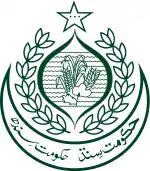Kalhora dynasty
The Kalhora dynasty (Sindhi: ڪلهوڙا راڄ) was a Sunni Muslim dynasty of Baloch people based in the region of Sindh of what is now Pakistan.[1][2][3] The Kalhora family , as will afterwards be seen , claimed an Arab and a holy origin.[4] The dynasty ruled Sindh and parts of the Punjab region between 1701 and 1783 from their capital of Khudabad, before shifting to Hyderabad from 1768 onwards. They were assigned to hold authority by the Mughal Grand Vizier Mirza Ghazi Beg and later formed their own independent dynasty, and they were known as the "Kalhora Nawabs" by the Mughal Emperors.[5]
| Kalhora dynasty ڪلهوڙا راڄ | |||||||||
|---|---|---|---|---|---|---|---|---|---|
| Autonomous Dynasty of Sindh | |||||||||
| 1701–1783 | |||||||||
 Flag | |||||||||
| Capital | Khudabad | ||||||||
| • Type | Nobility | ||||||||
| History | |||||||||
• Established | 1701 | ||||||||
• Disestablished | 1783 | ||||||||
| |||||||||
Part of a series on the |
|---|
| History of Sindh |
 |
| History of Pakistan |
The Kalhora dynasty succumbed to the Qizilbash during the invasion of Nadir Shah. Mian Ghulam Shah Kalhoro reorganised and consolidated his power, but his son lost control of Sindh and was overthrown by Talpurs Amirs. Mian Abdul Nabi Kalhoro was the last Kalhora ruler.[5]
Kalhora rule of Sindh began in 1701 when Mian Yar Muhammad Kalhoro was invested with title of Khuda Yar Khan and was made governor of Upper Sindh sarkar by royal decree of the Mughals. Later, he was made governor of Siwi through imperial decree. He founded a new city Khudabad after he obtained from Aurangzeb a grant of the track between the Indus and the Nara and made it the capital of his kingdom. Thenceforth, Mian Yar Muhammad became one of the imperial agents or governors. Later he extended his rule to Sehwan and Bukkur and became sole ruler of Northern and central Sindh except Thatto which was still under the administrative control of Mughal Empire.[5]
The Kalhora dynasty produced four powerful rulers namely, Mian Nasir Muhammad, Mian Yar Muhammad, Mian Noor Muhammad and Mian Ghulam Shah. Shrine of Shah Abdul latif Bhittai,(the poet of Sindh)was built by Kalhora rulers in 1772 century.rulers of Kalhora dynasty developed irrigation system , unified Sindh and defined its geographical boundaries'mproved literature and made it prosperous region , they built and laid the foundation stone of Hyderabad City in 1768 CE.
Military
As has been already stated the Kalhora army consisted of a large number of Baloch tribes. The Balochis had by this time become the strongest military force in the land. The early Kalhora had encouraged the Balochis to settle in Sind, in order that the Kalhoro might take advantage of this military superiority in the battlefield. The whole army of Kalhoras consisted of Balochis. After the successful revolt of the army the Talpur - Mirs became rulers of Sindh, the Kalhoras were completely wiped out.[6]
Rulers
- Mian Nasir Muhammad Kalhoro 1696-1701
- Mian Yar Muhammad 1701-1719
- Mian Noor Muhammad 1719-1755
- Muhammad Muradyab Khan 1755-1757
- Mian Ghulam Shah Kalhoro 1757-1772
- Mian Sarfraz Kalhoro (Khudayar Khan) 1772-1783
See also
External Links
— Imperial house — Cadet branch of the Abbasid Caliphate | ||
| Preceded by Mughal dynasty |
Monarchy 1701–1783 |
Succeeded by Talpur dynasty |
References
- Verkaaik, Oskar (2004). Migrants and Militants: Fun and Urban Violence in Pakistan. Princeton University Press. pp. 94, 99. ISBN 978-0-69111-709-6.
The area of the Hindu-built mansion Pakka Qila was built in 1768 by the Kalhora kings, a local dynasty of Baluchi origin that ruled Sindh independently from the decaying Moghul Empire beginning in the mid-eighteenth century.
- Ansari, Sarah F. D. (1992). Sufi Saints and State Power: The Pirs of Sind, 1843-1947. Cambridge University Press. p. 33. ISBN 978-0-52140-530-0.
Another key to Kalhora 'success' lay in their strengthening of the Baluchi element in Sind.
- Pakistan Quarterly. As the Kalhoras were also a Baloch Dynasty. 1958.
- Burton, Sir Richard Francis (1851). Sindh, and the Races that Inhabit the Valley of the Indus. W. H. Allen.
- Sarah F. D. Ansari (31 January 1992). Sufi Saints and State Power: The Pirs of Sind, 1843-1947. Cambridge University Press. pp. 32–34. ISBN 978-0-521-40530-0.
- Mirepoix, Camille (1967). Now Pakistan. Grenich.